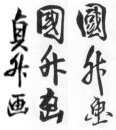Utagawa Kunimasu
Utagawa Kunimasu (歌川 国升) was a designer of ukiyo-e woodblock prints in Osaka who was active during the late Edo period.
[3] Kunimasu began experimenting with close-up actor portraits in this size in 1840, not long before the Tenpō Reforms were to disrupt yakusha-e production.
With the repeal of the Tenpō Reforms in the spring of 1847, Hirosada was to pioneer a revival of the chūban portrait format, likely through the financial support of Kunimasu.
"[10] Kunimasu in particular is credited with "expressing the psychology of stage performance through powerful and varied physiognomies and vivid or unusual placements of the figures in his compositions.
"[11] In 1852, Kunimasu and his student Hirosada visited Edo, where they joined with other pupils of Kunisada in creating background designs for a series of half-length actor portraits.
He ended his artistic career producing paintings in the style of the Shijō school, known for its blending of Japanese tradition with Western realism.



